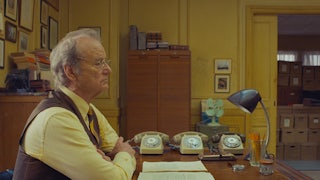Paul Thomas Anderson’s latest, Licorice Pizza, is a loose-jointed movie about two misfit kids in the San Fernando Valley in the 1970s, bouncing around a big jumble of Los Angeles sets—a movie agent’s office, a fancy restaurant, a movie star’s house, a gas station. It’s too meandering to really have a climactic scene, but the biggest and best moment, to my mind, is the one when Alana Kane (played by Alana Haim) freewheel-drives a large orange truck in reverse down a twisty, steep road, navigating using her side mirror. It’s a small action sequence, for a Hollywood picture, but it has that analog quality that makes it actually frightening.
Alana’s in the cab with a 15-year-old boy named Gary (Cooper Hoffman), who obviously can’t drive, his teenage friends in the back. She’s 25, but Gary, an earnest, aspiring junior hustler, managed to bug her into going on a date earlier in the film, when she insulted him and he was smitten. They forge a kind of awkward business partnership over that table, which gradually veers in and out (and in again) of romantic territory. Since the moment of their meeting, the pair have been on an odyssey of local entrepreneurship, hawking waterbeds and other fads that they think might sweep polyester-clad L.A. Hence the truck.
The big orange truck runs out of gas because Licorice Pizza is set during the fuel crisis, and L.A.’s pumps have run dry. In that little detail, the politics of the whole world rush in, as if to fill the void in the tank, making the truck seem impossibly heavy. Kane handles it with the Hollywood insouciance of Michael Caine in a Mini or Clint Eastwood on a horse, or like one of the girl gang in Les Pétroleuses—the 1971 Western famous for that image of Brigitte Bardot with a cigarette between her lips and her hair blowing across her face. Like that movie, about girls fighting over an oil field out West, Licorice Pizza is a petroleum story, one about a 1970s world equally in love with combustion engines and mass-produced plastics. The pair’s waterbed business goes under, for example, because, as Alana explains to Gary with the utmost derision, the “vinyl is made of oil.” They are protean young people, and like the plasticky, aromatic words licorice pizza, old slang for vinyl records and the logo for a chain of L.A. record stores, featuring a girl serving an L.P. on a platter, their romance is choreographed around oil and its transubstantiation into new, rubbery experience.
Like licorice itself, however, the celebrated director’s ninth feature film will probably either delight you or gross you out with its unrelenting sweetness. Although an alluringly atmospheric view of the 1970s is familiar from the rest of Anderson’s work, the new movie lacks the ambiguity and drama of his Boogie Nights (1997) and Inherent Vice (2014). The world of Licorice Pizza is built with beautiful attention to detail, all its surfaces practically glowing with polyester-induced static electricity, but its relentlessly upbeat mood combines with its two-hour-plus run time to produce monotony. The celebrated director’s ninth feature is full of heart and looks delicious but has no bite to speak of.
Perhaps it’s unfair to look for darkness from a movie set definitively in the cultural mainstream. Gary and Alana are not denizens of any countercultures, like the casts of Dazed and Confused (1995), Almost Famous (1999), or Casino (1995). Licorice Pizza echoes all those films in the way it envisions the 1970s as a lost era in American history, when times were perhaps tougher but in other ways simpler: no internet, moustaches worn in macho earnest, a buck to be made. As if reacting to the vinegary flavor of Gen X culture, those ’90s films all have a sweetness to them that is also a fantasy of naïveté. A good example would be the supposed health-giving benefits of cocaine in Boogie Nights. That sense of innocence even pervades the violent Casino—1970s America is a world full of people who do not know how much they do not yet know.
In Licorice Pizza, Anderson plays the darker sides of ’70s culture for laughs. Kane smiles and nods in response when another character comments about her “Jewish nose.” Then Anderson has restaurateur Jerry Frick (John Michael Higgins) do a hideously exaggerated, fake Japanese accent in front of real Japanese women. As Kyle Buchanan noted in his recent New York Times interview with Anderson, the audience at his screening “actually gasped” during these scenes, which also happened at the screening I attended in New York. It felt truly shocking. When Buchanan asked Anderson about it, he replied that he thought “it would be a mistake to tell a period film through the eyes of 2021.” Instead, he wanted “to be honest to that time.” He added: “Not that it wouldn’t happen right now, by the way. My mother-in-law’s Japanese and my father-in-law is white, so seeing people speak English to her with a Japanese accent is something that happens all the time.” Here Anderson veers close to a convincing argument—that anti-Asian racism is abundant in real life, and filmmakers shouldn’t pretend it didn’t exist. But there’s something so very tone deaf about dreaming up this fictional scenario, which is clearly signposted as comic. The second time the Japanese accent happens, Licorice Pizza starts to feel as if it’s taking delight in the deniability of the 1970s setting. It’s irrelevant to the plot, it empties out the sophisticated way the fuel crisis had organized the movie’s politics along real geopolitical lines, and it raises questions about Anderson’s judgment.
It’s not subtle, and nor is the music. Jonny Greenwood is credited with providing the score—after the huge success of his Phantom Thread soundtrack—but the soundtrack is dominated by familiar songs of the period: “Life on Mars,” “Peace Frog.” Like these song choices, which aren’t bad songs but are bad fits for a film that hopes to make anything other than the most obvious observations about the 1970s, newcomer actor Cooper Hoffman is miscast as Gary. Part of the problem is in the script: Gary is not a flawed antihero but a smiling, normal guy with none of the usual Andersonian irony about him. He’s a perfectly fine actor, but he’s simply wrong for the part. He doesn’t have the kind of sparkly darkness Anderson’s leading men—including his father, Philip Seymour Hoffman—have so reliably lent his projects in the past, bringing with them a focus, a center.
Like the scene with the racist accent and the disorientingly on-the-nose soundtrack, the casting is one of several deep problems running throughout Licorice Pizza—a film whose one-note romanticism is more rather than less disappointing in the light of its beautiful cinematography. After 133 lighthearted minutes, Licorice Pizza draws to a close without any of its eerinesses—the oil panic, the netherworld of Hollywood behind the scenes, a strange interlude featuring Sean Penn on a motorcycle—cohering into a center. Licorice Pizza is an oddly boring daydream, almost but not quite rescued by a magnetic leading lady.






